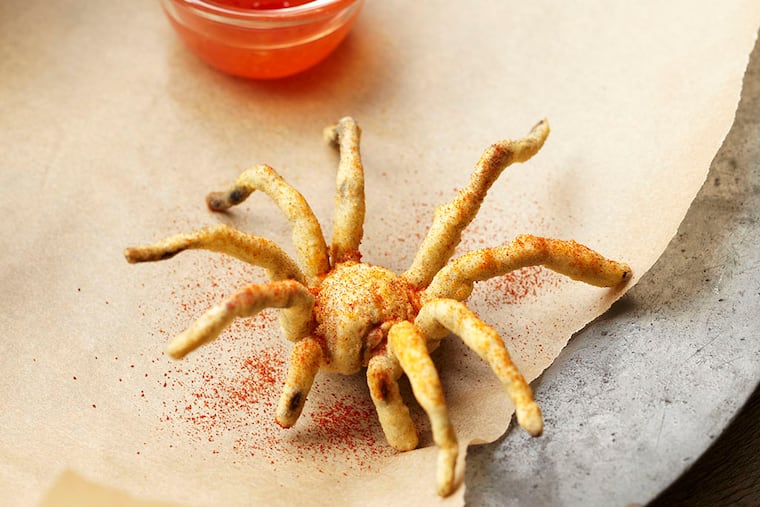Bugs are delicious (or, at least, trendy)
People all over the world eat crickets, grasshoppers, mealworms, ants, even tarantulas. At this years Bug Fest, you can, too.

IT'S A BUG'S world, and we're just living in - and now eating - it.
Credit (or blame) environmentalists. Or the push for healthier diets. Or the Internet. Regardless, cooking with insects - especially crickets, mealworms and wax worms - is trendy, spawning hundreds of Pinterest boards, cookbooks and the term "entopreneurs" (as in entomology), people profiting from this six-legged fad. The business-trend magazine Fast Company recently reported that the niche industry is worth $20 million and growing.
In two weeks - Aug. 8 and 9 - the Academy of Natural Sciences will host eminent bug chef, author and cultural-entomology enthusiast David George Gordon, who'll cook up fried tarantula, grasshopper kabobs and scorpion scaloppine to crowds on the Ben Franklin Parkway. (Earlier this year, he fed spiders, cockroaches and ants on a celery log to James Corden, Tituss Burgess and Anna Faris on the "Late, Late Show.")
So, if we can't beat them, can we eat them?
"At any angle you look at it, insects have the advantage," said Daniella Martin, creator of Girl Meets Bug, a blog dedicated to encouraging the public to eat insects. "They're ecologically sustainable, use less resources and are a high-protein option.
"It's also cleaner than livestock."
Scientists have discovered that more than 1,900 species of insects are edible. Most Americans might gag at the thought, but in Asia, Africa and Latin America insects are treats and can even be more expensive than meat, according to The Insect Cookbook. The 2012 book, written by entomologists and a chef, argues the benefits of eating insects for health - they are a good source of protein, amino acids and minerals, they say - and for the environment.
Their recipes include silkworm cookies, caterpillar stew, insect burgers and even "Hakuna Matata," which consists of rice, veggies and a wide variety of insects.
Gordon made that same argument - and offered just as edgy recipes - in his The Eat-a-Bug Cookbook, way back in 1998. "For the last 17 years, I've been cooking bugs all over the country and the world," he said, "That was before shows like 'Bizarre Food,' and 'Anthony Bourdain.' "
On her blog, Martin features cooking videos as well as insect recipes. The best - and tastiest - way to cook with bugs, she says, is to saute them like shrimp or roast them in the oven with a little olive oil and salt. For newbies, she recommends toasting wax worms in the oven to enhance their peanut flavor and eating them as a snack.
Bee larvae, she said, when sauteed in butter, taste like "mushroomy bacon." When mealworms are sauteed, roasted or boiled, they taste like nutty shrimp with juicy bodies. (So do crickets, added Gordon.) Seventeen-year cicadas, when cooked, are supposedly tender and delicious.
For his part, Gordon prefers black ants. "I recently bought six pounds of them from Thailand," he said. "That's a lot of ants." He described their flavor as "complex, sort of like soy sauce." Grasshoppers, not uncommonly eaten in Mexico, "taste a little bit like green pepper," he said, while "scorpions and tarantulas have a lot of meat in them, and are sort of like softshell crab."
DIYers can source organic crickets from a farm in Austin, Texas, or simply head to a pet store or bait and tackle shop. Gordon suggested seeking out Korean and Thai grocers for silkworm pupae and giant water bugs. Tarantulas can be pricey - Gordon's seen them for about $20 at the Petco - but you only live once, right?
For those who want to start simpler, Martin, who also authored Edible: An Adventure Into the World of Eating Insects and the Last Great Hope to Save the Planet, and Gordon both recommend buying products that subtly incorporate edible insects, such as cricket flour or cricket tortilla chips. The industry, she said, has grown to offer a diverse range of possibilities.
Crickets are among the most popular edible insects. San Francisco's Bitty Foods sells Chocolate Cardamom Cookies with cricket flour, Ontario's Next Millennium Farms ships several pounds of dried crickets and Rhode Island-based Exo offers four kinds of cricket protein bars.
"There are now a ton of products that won't gross you out," Martin said. "I promise."
And bugs have a noble purpose. The U.N. Food and Agriculture Organization reported in 2013 that edible insects could help fight world hunger because of their high nutritional value and low environmental impact.
"The case needs to be made to consumers that eating insects is not only good for their health, it is good for the planet," according to the report.
Two billion people around the world regularly eat insects, but that doesn't mean that many Americans will, said John Ruberson, the head of the entomology department at Kansas State University.
"People go out of their way to eat shrimp, but those are really like the cockroaches of the ocean," Ruberson said. "It seems we still have this aversion to eating insects."
Gordon, on the other hand, pointed out that we are already eating them. "A lot of us, whether we know it or not, are eating bugs already. The [FDA's] Food Defect Action Levels set allowable limits to the amount of bugs that can be in prepared foods.
"There can be as many as 56 bug parts in a peanut butter and jelly sandwich," he said.
Insect parts are intentional ingredients, too. Starbucks infamously employed crushed cochineals to color its Strawberries & Cream Frappuccino (it now uses tomato-based lycopene for the job). Raisinets are glazed in beetle juice shellac, "to keep them shiny and to prevent them from sticking together," said Gordon.
Suddenly, grasshopper kabobs sound a bit less exotic.
- Additional reporting by
Lauren McCutcheon